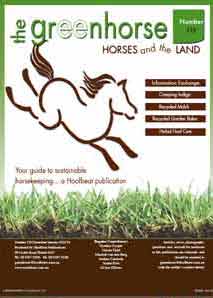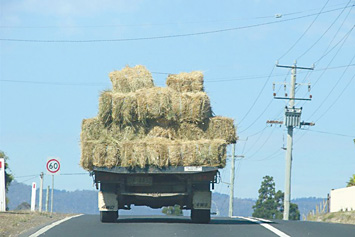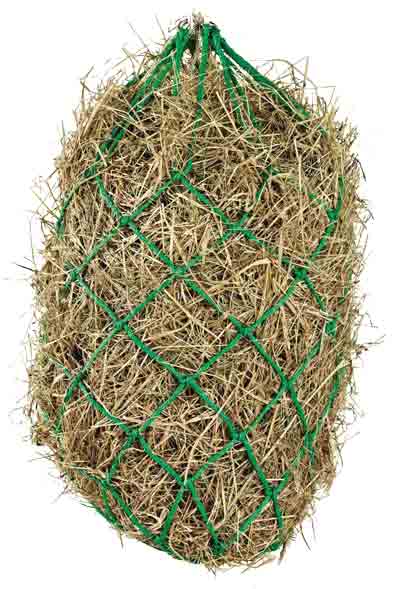The Green Horse section provides practical information on managing environmentally sustainable horse properties, readers stories and tips, as well as advice and articles from equestrian experts in their fields.
April/May 2016
Vol 37 No 6
In this issue of The Green Horse you will find the following articles:
Information Exchange
- a reader's story on fencing that bounced back after a tree fell on it.
Nerida Richards from FeedXL answers a question on the Paddy or pig mellon and if it can harm the horse.
Tasmania’s Hay Shortage.
Recycling Ideas - DIY feed bins and pot plants.
Great ideas for DIY feed bins using the blue plastic bins and creating very servicable feeders.
Aloe Vera by Angela Davison
Recognise this plant and its uses for horses and for humans.
Land Clearing Controversy in Queensland.
Historical Horse Trough.
White Sox - without harming the environment or the horse.
For those who are environmentally aware yet want their horse to have the 'glitz' and 'glam' for the showring.
Hay Net Research
Bore Bacteria
You may have had a bore on your property for years but been unaware of the need for 'conditioning' it to preserve the quality of water and protect the pipes.
WIN A YEAR'S SUBSCRIPTION...
share your equine related recycling ideas and each issue one reader will win.
Send ideas to Rebecca -
The Green Horse Support <thegreenhorse.assistant@gmail.com>

|
  
  

TASMANIAN HAY SHORTAGE

Tasmania’s state-wide hay shortage has reached crisis proportions according to grower group, Tasmanian Farmers and Graziers Association (TFGA). 2015 was dubbed one of the driest years on record with producers yielding as little as 10 per cent of their typical annual production. As a result, the price of hay has exploded with the price of square-bales rising from $8.00 each to $20.00 in some parts of the state, and large round bales inflating from $50 to $200. There have also been a number of reported hay thefts.
In one report, horse stud owner Graeme McCulloch said he’d be relying on leftover hay from last season to top-up the shortage. “It’ll certainly be about half the amount we normally cut,” he said. “I’ll manage but there’s not a lot of hay around this year, everyone’s scrounging around now, particularly the dairy industry.” In another report, hay supplier Geoff Wing said he was receiving an influx of calls but does not have enough stock to meet demand.
The TFGA say that hay supply has not been this bad since the 2006-07 drought years. “Normally you have a season in some districts and not others but this year it’s just been tough throughout the whole state,” the association’s Greg Gibson said. The Bureau of Meteorology’s (BoM) data record shows significant rainfall deficiencies across much of Tasmania over the past 18 months.
Many landholders are looking to sell their stock but with virtually everybody experiencing the same hardship, producers are asking ‘where do we sell the stock?’
The State Government has responded by announcing a $2.27 million package to help farmers, in November, but has been reluctant to use the term ‘drought’. Primary Industries Minister, Jeremy Rockliff, said he was confident the state was not in drought but that he is in regular contact with the Federal Agriculture Minister Barnaby Joyce.
HAY NET RESEARCH
Research by K. Martinson, E. Glunk and W. Weber from the University of Minnesota, USA.
Horses have evolved to consume several small, forage-based meals throughout the day, often spending greater than 14.5 hours grazing each day. However, many of today’s horses are housed in boxstalls or drylots, fed two large meals each day, and have limited opportunity to forage. To mimic a more natural feeding pattern many horse owners provide unlimited access to hay. In many cases, this results in obesity because the horses tend to consume hay in excess of their energy requirement. Therefore, it is of interest to identify feeding methods that reduce excess intake, but extend the foraging period beyond a few hours around meal time.
Objective
To investigate the effect of hay net design on the rate and amount of forage consumed by adult horses.
Materials and methods
Eight adult horses were fed in individual boxstalls. Horses were fed hay off the boxstall floor (control), or from one of three hay nets: large net (6 inch openings), medium net (1.75 inches) and small net (1.0 inch). Horses were acclimated to their assigned treatment for 2 days, followed by 3 days of data collection, and a wash-out period of 2 days. Horses had access to hay inside the nets for two 4 hour periods: 7:00 to 11:00 am and 4:00 to 8:00 pm each day. Throughout the trial, grass hay was fed at 1% body weight twice each day. To determine forage consumption rate, stopwatches were started once horses began eating, and stopped once horses either finished all offered hay, were no longer interested in eating, or the 4 hour time period had expired. All refused hay was collected and weighed. Total forage consumed was calculated by subtracting amount of refuse from hay offered.
Results
Mean consumption rates were 3.3, 2.9, 2.4, and 1.9 pounds per hour for the control, large net, medium net and small net respectively. Horses were able to consume all hay in the control and large net group during the 4 hour feeding period, but not all horses finished the hay meal when fed from the medium and small nets. Mean percentage of offered hay consumed was 95, 95, 89 and 72% for the control, large net, medium net and small net, respectively. A second study revealed that horses feeding from the medium net took just over 5 hours to consume the hay meal, while horses eating from the small nets took 6.5 hours to consume the meal. Both the control and large net resulted in consumption times of 3.2 and 3.4 hours, respectively.
Benefits to the equine industry
These results demonstrate that the small or medium nets were effective in decreasing rate and amount of forage consumed and increasing the total time of forage consumption by adult horses. If small or medium hay nets were used for twice daily feedings in a boxstall setting, the anticipated amount of time horses would spend foraging would be 10 to 13 hours each day; more closely mimicking a horse’s natural grazing behavior. Small and medium hay nets represent simple and affordable management tools for extending foraging time when meal feeding horses. However, use of the small and medium hay nets is not likely practical for all horses and it does take time (usually 4 to 5 feedings) for horses to acclimate to feeding from the nets |